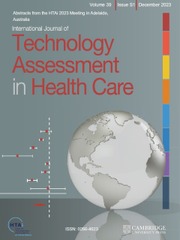Article contents
CAN ECONOMIC EVALUATION GUIDELINES IMPROVE EFFICIENCY IN RESOURCEALLOCATION?
The Cases of Portugal, the Netherlands, Finland, and theUnited Kingdom
Published online by Cambridge University Press: 25 May 2001
Abstract
The use of economic evaluation in decision making appears to haveincreased over the past few years and economic evaluation is lookedupon as another measure to help contain costs and improve efficiencyin an evidence-based decision-making environment. Following theexamples of Australia and the Canadian Province of Ontario, fourEuropean Union (EU) countries (Finland, the Netherlands, Portugal, andthe United Kingdom) have recently introduced economicevaluation guidelines. In addition to the Australian and Canadianguidelines, which constitute a hurdle to reimbursement, the paradigmthat seems to be evolving in the four EU countries follows a similarroute. Finland and the Netherlands seem to be moving toward thenotion of a fourth hurdle to reimbursement, whereas the NationalInstitute for Clinical Excellence in England and Wales was inprinciple meant to influence practice, although in reality thisessentially acts as a hurdle to reimbursement, requiring a differentdata set to that used by regulatory authorities. Whereas thePortuguese guidelines were developed to assist in preparing economicsubmissions to support reimbursement decisions, they are unclearabout when such evidence will be required and also discuss thedissemination of economic evidence to broader audiences. Theintroduction of these guidelines poses a number of challenges topolicy makers, the implications of which are analyzed in the paper:a) to ensure that economic evaluations are carried out scientificallywithout industrial or political bias; b) to define an acceptablemethodology that would increase their credibility; and c) to addresscertain practical issues ranging from deciding how to use economicevaluations in policy making to setting up new institutions orimproving the coordination and dissemination of evidence. Thevariation in the use of economic evaluation guidelines in the four EUcountries highlights the differences in national pharmaceuticalpolicies and is in line with policy makers' continuous attempts tocontain costs. While the paper critically discusses the guidelines,it also points out that a series of methodologic issues need to beaddressed if economic criteria are to be introduced in policy makingwith the aim to improve resource allocation. The paper concludes thateconomic evaluation as a discipline is beginning to impact on policy,whereas the consistent use of economic evaluation results is, inprinciple, being adopted by policy makers but needs to go a stepfurther to reach practitioners.
Keywords
Information
- Type
- Research Article
- Information
- International Journal of Technology Assessment in Health Care , Volume 16 , Issue 04 , October 2000 , pp. 1179 - 1192
- Copyright
- © 2000 Cambridge University Press
- 26
- Cited by

